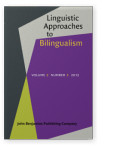Commentary
Variable competence
References (41)
References
Ambridge, B., & Lieven, E. (2011). Child language acquisition: Contrasting theoretical approaches. Cambridge: Cambridge University Press. 

Beckner, C., Blythe, R., Bybee, J., Christiansen, M.H., Croft, W., Ellis, N.C., Holland, J., Ke, J., Larsen-Freeman, D., & Schonemann, T. (2009). Language is a complex adaptive system. Position paper. Language Learning, 59(Supplement 1), 1–26.
Bock, J.K. (1986). Syntactic persistence in language production. Cognitive Psychology, 181, 355–387. 

Bod, R., Hay, J., & Jannedy, S. (Eds.). (2003). Probabilistic linguistics. Cambridge, MA: MIT Press. 

Chipere, N. (2001). Native speaker variations in syntactic competence: Implications for first language teaching. Language Awareness, 101, 107–124. 

Christiansen, M.H., & Chater, N. (2008). Language as shaped by the brain. Behavioral & Brain Sciences [target article for multiple peer commentary], 311, 489–509. 

Collins, L., & Ellis, N.C. (2009). Input and second language construction learning: frequency, form, and function. Modern Language Journal, 93(2).
Dąbrowska, E. (1997). The LAD goes to school: A cautionary tale for nativists. Linguistics, 351, 735–766. 

Dąbrowska, E. (2008a). The later development of an early-emerging system: The curious case of the Polish genitive. Linguistics, 461, 629–650. 

Dąbrowska, E. (2008b). The effects of frequency and neighbourhood density on adult speakers’ productivity with Polish case inflections: An empirical test of usage-based approaches to morphology. Journal of Memory and Language, 581, 931–951. 

Dąbrowska, E., & Street, J. (2006). Individual differences in language attainment: Comprehension of passive sentences by native and non-native English speakers. Language Sciences, 281, 604–615. 

Divjak, D.S., & Gries. S.T. (Eds.). (in press). Frequency effects in language: Linguistic representation. Berlin: Mouton de Gruyter.
Ellis, N.C. (2002). Frequency effects in language processing: A review with implications for theories of implicit and explicit language acquisition. Studies in Second Language Acquisition, 24(2), 143–188. 

Ellis, N.C. (2005). At the interface: Dynamic interactions of explicit and implicit language knowledge. Studies in Second Language Acquisition, 271, 305–352. 

Ellis, N.C. (2006). Selective attention and transfer phenomena in SLA: Contingency, cue competition, salience, interference, overshadowing, blocking, and perceptual learning. Applied Linguistics, 27(2), 1–31. 

Ellis, N.C. (2008). Optimizing the input: Frequency and sampling in Usage-based and Formfocussed Learning. In M.H. Long & C. Doughty (Eds.), Handbook of second and foreign language teaching. Oxford: Blackwell.
Ellis, N.C. (2011). Frequency-based accounts of SLA. In S. Gass & A. Mackey (Eds.), Handbook of second language acquisition (pp. 193–210). London: Routledge / Taylor Francis.
Ellis, N.C., & Cadierno, T. (Eds.). (2009). Constructing a second language (Vol. Special section, 7).
Ellis, N.C., & Larsen-Freeman, D. (2006). Language emergence: Implications for Applied Linguistics. Applied Linguistics, 27(4). 

Ellis, N.C., & Larsen-Freeman, D. (2009). Language as a Complex Adaptive System (Special Issue). Language Learning, 59(Supplement 1), 1–27.
Ellis, N.C., & O’Donnell. M.B. (2011). Robust language acquisition — an emergent consequence of language as a complex adaptive system. In L. Carlson, C. Hölscher, & T. Shipley (Eds.), Proceedings of the 33rd Annual Conference of the Cognitive Science Society (pp. 3512–3517). Austin, TX: Cognitive Science Society.
Ellis, N.C., & O’Donnell. M.B. (2012). Statistical construction learning: Does a Zipfian problem space ensure robust language learning? In P. Rebuschat & J.N. Williams (Eds.), Statistical Learning and Language Acquisition. Berlin: Mouton de Gruyter.
Ellis, R. (1985). A variable competence model of second language acquisition. IRAL, 231, 47–59.
Ellis, R. (2008). The study of second language acquisition, (2nd ed.). Oxford: Oxford University Press.
Evans, N., & Levinson, S.C. (2009). The myth of language universals. Behavioral and Brain Sciences, 321, 429–492. 

Gregg, K.R. (1990). The variable competence model of second language acquisition, and why it isn’t. Applied Linguistics, 11(4), 364–381. 

Gries, S.T., & Divjak, D.S. (Eds.). (in press). Frequency effects in cognitive linguistics: Statistical effects in learnability, processing and change (Vol. 1). Berlin: Mouton de Gruyter.
McDonough, K., & Mackey, A. (2008). Syntactic priming and ESL question development. Studies in Second Language Acquisition, 301, 31–47. 

McDonough, K., & Trofimovich, P. (2008). Using priming methods in second language research. London: Routledge.
Pickering, M.J., & Ferreira, V.S. (2008). Structural priming: A critical review. Psychological Bulletin, 1341, 427–459. 

Pickering, M.J., & Garrod, S.C. (2006). Alignment as the basis for successful communication. Research on Language and Computation, 41, 203–228. 

Robinson, P., & Ellis, N.C. (Eds.). (2008). A handbook of cognitive linguistics and second language acquisition. London: Routledge. 

Slobin, D.I. (1997). The origins of grammaticizable notions: Beyond the individual mind. In D. I. Slobin (Ed.), The crosslinguistic study of language acquisition (Vol. 51, pp. 265–323). Mahwah, NJ: Erlbaum.
Street, J., & Dąbrowska, E., 2010. More individual differences in language attainment: How much do adult native speakers of English know about passives and quantifiers? Lingua 1201, 2080–2094. 

Tarone, E. (1988). Variation in interlanguage. London: Edward Arnold.
Tomasello, M. (2003). Constructing a language. Boston, MA: Harvard University Press.
Trousdale, G., & Hoffmann, T. (Eds.). (2012). Oxford Handbook of Construction Grammar. Oxford: Oxford University Press.
Williams, J.N., & Rebuschat, P. (Eds.). (2012). Statistical learning and language acquisition. Berlin: Mouton de Gruyter.
Cited by (3)
Cited by three other publications
Gudmestad, Aarnes, Amanda Edmonds & Thomas Metzger
2020.
Modeling variability in number marking in additional-language Spanish.
Journal of the European Second Language Association 4:1
► pp. 24 ff.

Hulstijn, Jan H.
2019.
An Individual‐Differences Framework for Comparing Nonnative With Native Speakers: Perspectives From BLC Theory.
Language Learning 69:S1
► pp. 157 ff.

This list is based on CrossRef data as of 10 august 2024. Please note that it may not be complete. Sources presented here have been supplied by the respective publishers.
Any errors therein should be reported to them.
